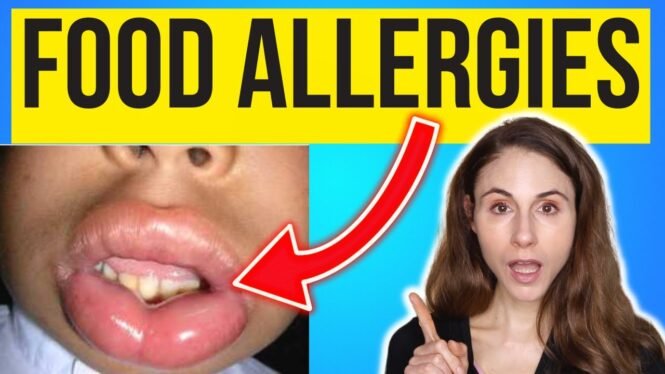Are you experiencing skin irritations that seem to be persistent? Did you know that they could be caused by the food you consume? In this blog post, we will discuss the skin signs of food allergies, with insights from the reputable dermatologist @DrDrayzday. As someone who has expertise in this area, Dr. Drayzday will share vital information about the signs and symptoms that you should look out for to help you identify and manage your food allergies. Read on to learn more about this important topic.
Skin Signs of Food Allergies: A Dermatologist’s Perspective
As much as we love our food, sometimes our body doesn’t reciprocate the love. Food allergies have become more common than ever, affecting millions of individuals worldwide. But how can we tell if we have food allergies, and what signs of allergies should we look out for?
In this article, we will be discussing the different skin signs of food allergies, how allergies work, histamine in foods, and ways to get rid of hives. We have also included several FAQs at the end of this article to help you better understand food allergies and how it affects your skin. So, let’s dive in!
Introduction
Food allergies can affect anyone, anywhere, and at any given time. It doesn’t matter if you’re young or old, healthy or sick, allergies can catch you off guard. One of the most apparent symptoms of food allergies is the effect it has on your skin. Red, itchy, and raised bumps also known as hives are a tell-tale sign that your body is having an adverse reaction to food.
At times these rashes can be severe enough to warrant hospitalization. In this article, we will be exploring some of the most surefire signs that demonstrate the body’s reaction to food. Let’s start.
Foods Causing Hives
Hives are the classic allergic-reaction symptom and can result from sauces, dairy, fruits, and nuts, to name a few. Hives form due to the release of histamines from the mast cells in our skin. The most common allergen food sources that cause hives include nuts, shellfish, chocolate, berries, and milk.
Signs of Hives:
- Red or pale red bumps
- Raised bumps which are often itchy
- The area around the rash is swollen and inflamed
- Rashes can grow in size or merge with other bumps
Histamine in Foods and Histamine Food Poisoning
Histamine occurs naturally in certain foods like fish and cheese. It is a chemical that is responsible for allergic reactions, including hives. Foods that are high in histamines include fermented foods, aged cheese, soy sauce, wine, and vinegar.
Histamine poisoning can cause a variety of symptoms beyond skin issues. For example, it can lead to cramps and diarrhea, flushing, a headache, and difficulty breathing. Histamine intolerance can affect a wide array of people, and the symptoms of such intolerance can mimic those of a food allergy.
Foods Causing Facial Redness
Facial redness is another symptom of food allergy that can often be mistaken for flushing or rosacea. Foods like spicy food, alcohol, and red wine, and hot beverages like coffee and tea can cause facial redness in some people.
Facial redness has several other possible culprits, except for food. Rosacea, psoriasis, eczema, sensitive skin, and stress can all cause facial redness. Drink plenty of water and avoid foods that cause facial redness if you suspect that it is triggered by food allergies.
Tips on Getting Rid of Hives
Hives are terrible to deal with, but the good news is that some simple tips can help reduce the severity of the reactions. Here are some tips:
- Avoid consuming foods that you know you’re allergic to and check the ingredients list before consuming any food.
- Take an antihistamine, such as Benadryl, for minor reactions.
- Cold compressions can help to reduce itching.
- Over-the-counter creams like hydrocortisone can be applied topically to help reduce inflammation.
Remember that if your symptoms persist, it’s important to consult a healthcare professional to get a proper diagnosis and treatment options.
Conclusion
In conclusion, food allergies are a serious issue that should not be taken lightly. Skin signs of food allergies, like hives and facial redness, can often be the first signal that the body is reacting to allergens. Histamines are the primary culprit in food allergies and are found in several foods, causing histamine poisoning. We hope that this article has shed some light on the different skin signs of food allergies and how to manage them effectively.
FAQs
- What are the most common food allergens?
The most common food groups that typically cause allergic reactions are milk, peanuts, tree nuts, shellfish, fish, egg, soy, and wheat.
- Can you develop food allergies later in life?
Yes, it is possible to develop food allergies later in life. Anyone can get food allergies; it doesn’t matter your age or whether you’ve had the food before without a reaction.
- What are the symptoms of histamine intolerance?
Symptoms of histamine intolerance can include headache, dizziness, itching, facial flushing, and digestive discomfort, among others.
- What are good antihistamine options?
Antihistamines such as Benadryl, Allegra, Claritin, and Zyrtec are the most commonly used allergy medications.
- How are food allergies diagnosed, and what treatments are available?
There are various diagnostic tests like skin-prick and oral food challenge to diagnose food allergies. Treatment options include avoiding the allergenic food, medications, and immunotherapy.
Disclaimer: The information provided in this article is for informational purposes only. The statements made about specific products have not been evaluated by the Food and Drug Administration. This content is not intended to diagnose, treat, cure, or prevent any disease. Please consult with your healthcare professional before making any lifestyle changes or trying new products.
Don’t forget to check out our Amazon store and social media links for more information!

